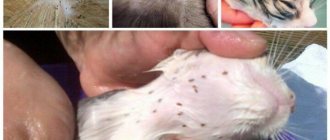Even if a cat or dog is domestic and does not leave the house for a walk, this does not mean that it is completely immune from such a scourge as ectoparasites. Fleas, ticks and lice eaters can get on an animal's fur and thus cause a lot of problems, because parasites are carriers of various diseases.
One way to protect your pet from harmful insects is an insecticidal collar. However, many owners doubt its effectiveness. We will try to figure out how effective it is.
How dangerous are bloodsuckers?
Bloodsuckers can cause a number of diseases and complications. To minimize the risk, they need to be eliminated quickly. They should also be feared because:
Bloodsuckers can cause a number of diseases and complications
- they carry a large number of diseases, even fatal cases occur;
- due to the fact that babies do not have enough red blood cells, a large number of insects causes anemia;
- due to the saliva of parasites, allergies appear (itching, redness, other symptoms);
- bites lead to infection or dermatitis;
- blood-sucking insects are carriers of helminths.
Fleas are especially dangerous in a puppy under 1 month of age, since the baby does not yet have the proper immunity. There is a high risk of complications of the disease, sometimes leading to death.
Advertising:
How the collar works
The anti-tick and flea collar is made of a special material that is impregnated with special substances that are gradually released and distributed throughout the body of cats or dogs. Due to the parasite repellent drugs used, the collar may have an unpleasant odor.
The effect of using the collar does not appear immediately, but after a few days. To protect cats from parasites, the collar must not be removed, even for a short time, otherwise the effectiveness of the collar will become significantly lower. The duration of the collars depends on the brand chosen, on average it is 4-7 months, but it is recommended to replace the collars a little earlier than their expiration date.
Protection methods
There are several ways to remove fleas from a 1 month old puppy. At home, this is done using special devices (shampoos, drops, collars) or folk methods.
Fleas are especially dangerous in a puppy under 1 month of age, since the baby does not yet have the proper immunity.
The first thing you should pay attention to is the age of the animal. For a one-month-old puppy (up to six weeks), regular bathing is sufficient. The water should be at a suitable temperature - 37-40°C. The animal's fur must be wetted, keeping its head above the water, and then wiped thoroughly (most importantly, gently). Immediately after this, wrap it in a towel and dry it well. Then you need to carefully comb the fur with a special comb. When everything is done, you need to look at your pet's skin and then manually remove any remaining insects.
This happens: the animal experiences itching, but there are no parasites. It turns out that there are a number of factors that cause itching in a small pet. These include:
- stress;
- ectoparasites;
- allergies;
- a number of skin diseases;
- hyperfunction of the sebaceous glands;
- endocrine pathologies;
- reproductive system problems;
- the presence of malignant processes.
Today there are a large number of drugs that can be used to treat young dogs.
It is almost impossible to identify all diseases on your own.
Therefore, when you first notice how your animal is constantly itching, you need to seek help from a veterinarian. He will accurately determine the cause of the discomfort.
Rating of the best drugs
Today there are a large number of drugs that can be used to treat young dogs. However, despite all the diversity, it is quite difficult to remove parasites, so you need to know exactly which remedy is best.
All drugs are divided into several groups:
- shampoos;
- drops;
- sprays;
- solutions (for example, hellebore water);
- collars.
The undisputed leader among shampoos is Beaphar.
The undisputed leader among shampoos is Beaphar. This is confirmed by numerous certificates, as well as the great popularity of the company’s products. Animal shampoo has four levels of action:
- Fight against parasites.
- Preventing re-infection.
- Cleaning areas where an infected puppy has been.
- Deworming.
Shampoo is used once. It is important to avoid contact with the mucous membranes of the eyes, ears or tongue.
Drops are no less effective. This product is applied only to the neck area - where the dog cannot reach with its tongue and paws. This is necessary to prevent the pet from licking the poison. Babies can be given drips from the age of one month. The animal should not get wet for 24 hours after the procedure, so you should not bathe it or walk with it in the rain. To get the best effect, the animal can be treated several times.
Shampoo is used once. It is important to avoid contact with the mucous membranes of the eyes, ears or tongue.
The third option is a special collar for your pet. It is used for the prevention of infection rather than for treatment. You can be sure that there are no fleas if you constantly follow preventive measures. The collar can be used at any age, which is especially suitable for small pets.
The choice of other options is large - drops, solutions, and shampoos. What is the best flea treatment for puppies? The question is controversial. It is advisable to use several options.
Types of anti-tick and flea collars
Different collars use different substances that have greater or lesser toxicity and effectiveness against parasites. Collars for cats and dogs are divided into three types.
- Biological - have a repellent effect; they contain various herbs and essential oils that are unpleasant for parasites. Such collars have low toxicity, which allows their use on weakened animals, pregnant women or kittens and puppies.
- Chemical - such collars can only be used on adult and healthy animals. They protect animals more reliably than the previous ones, but are more toxic, which makes their use not always rational.
- Ultrasonic - such devices can be used for all animals, they are completely safe and do not emit odor. Ultrasonic collars operate due to ultrasonic or electromagnetic waves emitted by the device. Many people complain that devices in this group are ineffective.
Traditional methods
If you do not trust radical drugs, there are a large number of folk remedies that allow you to get rid of fleas without harming puppies. Often these are homemade lotions, shampoos or sprays that have a negative effect on insects.
Note: such folk remedies for fleas for small dogs should be made only from fresh ingredients, without an allergic reaction.
Here are a few recipes that can destroy bloodsuckers:
- Herbal decoction. They use wormwood, calamus, tansy, mint, wild rosemary. The herbs are boiled together, or only one of the listed ones is taken. It is important that the broth is strong and warm. We wet the dog's fur, raising his head above the water. Keep for 15 minutes. Afterwards, wipe thoroughly with a towel. Comb out. The product is an excellent substitute for shampoo thanks to the natural ingredients of the decoction.
- Tar soap. The pet must be wet, thoroughly soaped, wrapped in film and then with a towel. Keep it like this for up to 20 minutes. Rinse off the soap, dry the animal with a towel, and comb it out.
These two methods are the most effective. With their help, you will be able to overcome the bloodsuckers without harm to the baby.
Prevention measures are directly determined by where the dog is - in a new family, where he is alone, or together with his relatives.
Ultrasonic collar
The ultrasonic collar is suitable for protecting cats and dogs; it comes in the form of medallions that cling to the collar.
An ultrasonic collar repels parasites by emitting sound waves that are inaudible to the human ear, but highly irritating to parasites. A parasite caught under the influence of an ultrasonic trap immediately tries to move away from the source of the signal radiation.
An ultrasonic collar has a big advantage compared to collars that use chemicals, since it is completely safe for the health of cats, dogs, people and other animals.
Before purchasing such a device, it is better to read reviews from people who have already used the device on their pets. Many people claim that the device does not help at all against parasites living on animals.
Prevention
Prevention measures are directly determined by where the dog is - in a new family, where he is alone, or together with his relatives.
In the first case, fleas should be poisoned using medications. They are also used for prevention. In this case, collars are best suited.
When the pet is with the family, all toxic substances must be excluded. Drugs from the skin of some dogs, when washed by the mother, can get into other babies. This will lead to their poisoning or even death. Therefore, it is necessary to use natural preparations here.
It is best to use the scents of wormwood, mint, lavender, bedbug, sweet clover, tansy or flea beetle. The herbs themselves, their oils or powders should be scattered on the floor of the room where the pets spend the most time. The outer part of the lounger (the one that touches the floor) is impregnated with herbal oils. The strong aroma will repel insects.
It is best to use the scents of wormwood, mint, lavender, bedbug, sweet clover, tansy or flea beetle.
Collar Scalibor
The Scalibor insecticidal-acaricidal collar is suitable for protecting your pets against most types of parasites that can settle on your pet (fleas, ticks, lice). The active component of the Scalibor collar is deltamethrin; there are also additional components that act as excipients.
The Skalibor collar is sold in sizes 48 cm and 65 cm for medium and large types of dogs. The “Skalibor” is placed around the dog’s neck so that fingers can be inserted between them, and the excess part of the collar is cut off. Like all similar collars, “Skalibor” begins to work after a few days on the dog, the maximum effect appears after a week.
"Skalibor" can be used on puppies over two months of age. Duration of action is up to 6 months. When bathing a dog in a pond or river, the Scalibor collar should be removed to avoid poisoning the river inhabitants. The dog’s protection itself after getting wet is not reduced by constantly wearing the Scalibor collar.
How to protect babies under 1 month from bloodsuckers?
Babies are especially helpless in front of insects. Most flea treatments are not available for puppies under 1 month of age. They are commercially available, but cannot be used at such an early age. During the first 4-5 weeks, a small dog develops its own immunity, and then the work of the immune system begins.
However, how then can you get rid of fleas on a puppy? It is necessary to resort to a folk remedy for fleas - a strong decoction or tar soap. First of all, it is advisable to try decoctions, since they are not so “nuclear” and are easier for the baby to tolerate.
Collar Kiltix
The Kiltix collar is made of polyvinyl and is a ribbon of a certain length for different sizes of dogs: 66 cm for large dogs, 48 cm for medium dogs and 35 cm for small dogs.
"Kiltiks" uses drugs such as propoxur and flumethrin against ticks; they are gradually released from the collar and get onto the pet's fur and skin. Kiltix is well tolerated by dogs and does not cause irritation or side effects. The Kiltix collar can be dangerous for small animals (rats, hamsters, birds).
The Kiltix collar is indicated for protecting animals from ticks, fleas, lice, lice, mosquitoes and other insects. After printing, the collar is untwisted and put on the dog so that there is 1.5 cm of space between the Kiltix collar and the skin. After the collar is put on and fastened, you should cut off the excess piece so that the dog cannot reach it.
In the first few days, ticks and other parasites may cling to the dog, so you should refrain from walking in suspicious places. The collar will protect your pet from parasites for 7 months, provided that it is constantly worn.
Protection for 2 months
Almost everyone knows how to remove fleas from a 2-month-old puppy. A strengthened body can withstand a number of treatments without any problems, namely shampoos, sprays, drops and collars.
The first product used is chosen to be as soft as possible.
Important: all substances must be as natural as possible. More persistent poisons are allowed from the age of 5 months.
The first product used is chosen to be as soft as possible. It is advisable to start with shampoos and consolidate the results with a collar. You only need to put a flea collar on a dry pet, so there is no need to bathe him beforehand.
However, remember that it is not only the pet that needs to be treated, but also the place where it lives.
How to choose a collar
Before purchasing, you should decide which collar you plan to buy, then follow the tips described below and buy the collar.
- Brand – choose collars from well-known and reputable companies.
- General information - before purchasing a collar, carefully read the instructions and ingredients of the medications.
- Low cost - you can buy a fake or low-quality product, so it is better to buy collars in specialized stores.
- Reviews – Before going to the store, read reviews of the most common collars to choose the best option.
- Collar size and type – depending on the pet you plan to put a collar on, you should choose a narrow and short one or a wide and long one.
All collars are adjustable in length and the excess piece can be cut off so that it does not interfere with your pet.
Protection for 3 months
Treat animals 3-5 months old. permissible with all arsenal of means. Moreover, it is allowed to use more durable and strong products that will destroy all insects in just one procedure.
You only need to put a flea collar on a dry pet, so there is no need to bathe him beforehand.
When choosing flea treatments for puppies over 2 months of age, pay attention to the indicated age and weight of the pet, ingredients, method of application, and speed of action.
Important: the chosen option must act gently. Rapid action indicates a strong poison that will harm a small animal.
Pros and cons of anti-parasite collars for cats and dogs
Like everything that exists, cat collars have their positive and negative aspects; below we will analyze whether it is worth using a collar or whether it is better to choose something else.
Pros of collars
- Easy to use - unlike other means of protection against parasites, you just need to put the collar on in the spring and you can forget about parasites for the entire warm season.
- Reliability – good collars guarantee protection for your pet for the entire period specified in the instructions.
- Cheap - since one collar lasts for 4-6 months, it will cost less than drops or aerosols that should be used to treat the animal every week.
- Practicality - using the collar does not cause difficulties and does not take time to process. Also, the collar will not stain furniture or carpet, unlike liquid protective equipment.
Cons of collars
- Efficiency - collars often lose their protective properties much earlier than the manufacturer indicates on the label. Also, cheap collars do a poor job of repelling parasites, and they move through the animal’s fur in an inhibited state.
- High toxicity - collars are impregnated with potent substances that destroy parasites. In most cases, they do not harm the animal, but there are cases when animals suffer serious skin injuries and even poisoning from insecticides in the collar.
- Chronic diseases - this information is kept silent by the collar manufacturers themselves, but if you regularly use a parasite collar, after a few years the animal may develop diseases that are caused by toxic substances in the collar. They do not lead to serious diseases, but diseases of the thyroid gland, liver and kidneys are also quite dangerous.
Be aware of the negative effects of parasite control and do not neglect your pet's health. If you use a collar or other means to repel parasites, carefully monitor the condition of your pet and at the first signs of poisoning or an allergic reaction, immediately contact a veterinary clinic.
User reviews
Marta, 32 years old: “I was advised to use a collar for my Marsik as a preventive measure. However, for a long time I wondered: “When can I put a flea collar on a small puppy?” The internal struggle in me was resolved by a pharmacist who also has a pet. I’ll be honest, I changed collars several times over the course of a year, but I never regretted my choice.”
Oksana, 28 years old: “With the advent of the little Rottweiler, I was interested in only one question: “Can one-month-old puppies be treated for fleas?” And if so, then with what. I chose the best option - Beaphar shampoo. To be more reliable, I used it twice, and now there are no insects on our baby.”











